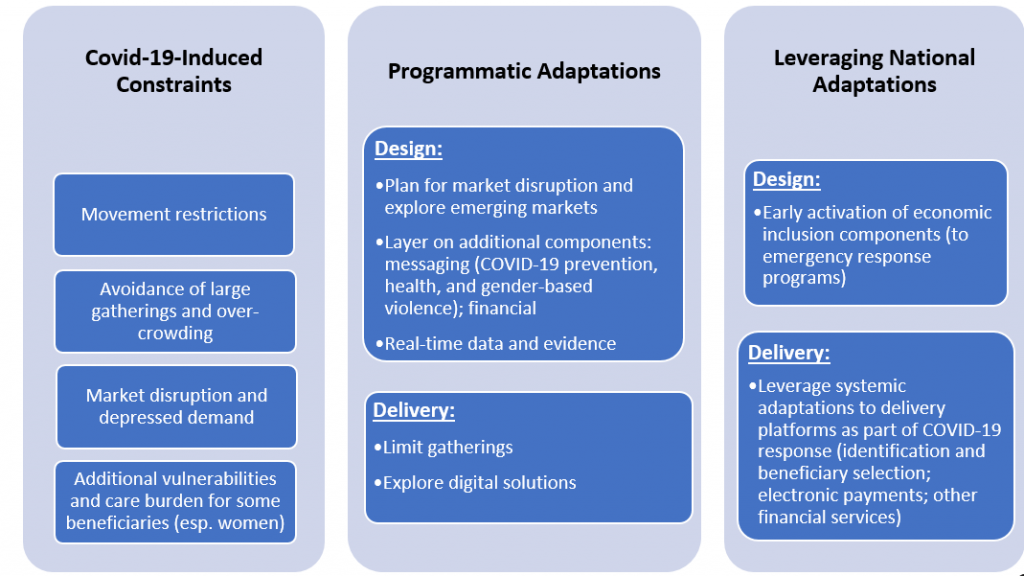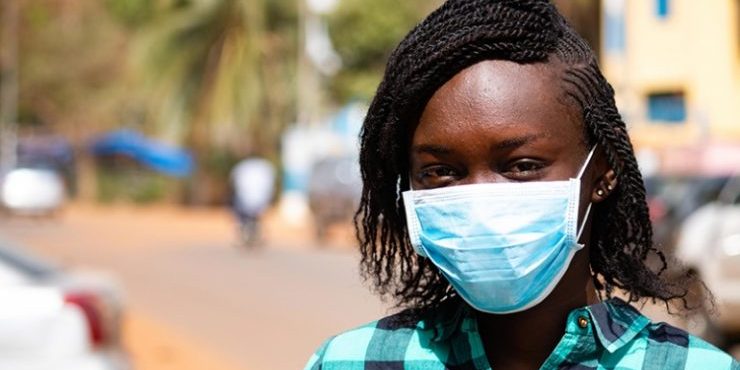People take precautions in Mali against COVID-19 (coronavirus). Photo credit: Ousmnane Traore/World Bank
Authors: Puja Vasudeva Dutta, Colin Andrews, Aude de Montesquiou, Timothy Clay, and Sarang Chaudhary
This blog post is based on the forthcoming Partnership for Economic Inclusion Policy Note Series: Economic Inclusion for the Poorest & COVID-19: Adaptation and Early Priorities for Medium- and Longer-Term Recovery.
As part of a broad spectrum of coronavirus-related (COVID-19) priorities, countries are working to protect their poorest by identifying sustainable livelihood support. Fortunately, there is already a credible base of existing economic inclusion programs that form an immediate platform to support local livelihood recovery. Emerging experiences across a range of countries – including Sahel, Bangladesh, Peru, and India – highlight the early priorities and adaptations now taking place, with many building on existing safety net programs.
How can economic inclusion programs help meet the challenges of COVID-19?
#1: At least 75 countries already have economic inclusion programs that provide an immediate platform to support local livelihood recovery and broader replication. Share on X These programs, which offer a multi-dimensional set of “bundled interventions” to support households and communities to increase their incomes and assets, were already surging before the pandemic struck (see Figure 1). The programs serve 20 million households and benefit over 90 million individuals, either directly or indirectly.
Figure 1: Regional distribution of economic inclusion programs (percent of programs and beneficiaries)

#2: Government-led programs show strong potential to reach a wide population while relying on partnership collaboration to ensure smooth program delivery. Share on X Government-led programs featured in the forthcoming PEI State of Economic Inclusion report cover 95 percent of beneficiaries. As these programs evolve, they tend to build on large-scale anti-poverty programs, often already focused on safety nets, livelihood and jobs, and financial inclusion efforts. Common interventions include a combination of cash or in-kind transfers, skills training or coaching, access to finance, and linkages to market support. Partnership is integral for program success given the multidimensional nature of program delivery. Sixty-seven percent of programs reviewed partner with NGOs to deliver programs.
After years of steady build-up, economic inclusion programs are well placed to respond to new COVID-19 realities.
#3: Economic inclusion programs are flexible and serve multiple objectives. Share on X The most frequently cited objectives of economic inclusion programs are self-employment, income diversification, and resilience. In addition, one in three programs focuses on displaced populations.
#4: Though COVID-19 brings new constraints to program design and delivery, economic inclusion programs can quickly adapt by leveraging local structures and existing capacities such as digital platforms. Share on X Figure 2 maps out a framework for early adaptations to program design and delivery. Furthermore, while programs are well-equipped to adapt to COVID-19 constraints, new challenges and opportunities emerge in scaling programs. They include: (i) adapting to uncertainty, (ii) maintaining political commitment given competing priorities, (iii) program costs and availability of financing, (iv) inter-agency coordination, and (v) sustaining partnerships at the local and global level.
Figure 2: Framework for early adaptations to program design and delivery

Adapting economic inclusion program design and delivery to respond to COVID-19
#5: Some adaptions can be made in program design and delivery in order to better operate in a pandemic setting. Share on X Key priorities in adapting program design include: (i) mitigating health risks, for example by linking to health insurance and including health messaging; (ii) coping with market disruptions and anticipating possible livelihood opportunities (e.g. NRLM); and (iii) strengthening real-time evidence generation (e.g. BRAC Rapid Perception Survey). Key priorities in adapting program delivery include: (i) early activation of economic inclusion components in new programs, especially cash transfers; (ii) scale up of digital solutions for delivery of key program components (e.g. SPACE); and (iii) identification of practical measures to maintain social distancing.
#6: Multidimensional economic inclusion packages are well-positioned to help women to address the plurality of COVID-19 related constraints. Share on X Women are overrepresented in sectors and occupations that are most affected by COVID-19, such as education, retail, travel, leisure, hospitality, and domestic services. Lessons from previous crises highlight declining opportunities for women, de-prioritization of female health services, and increased gender-based violence. Economic inclusion programs serve as a strong base of support with 88 percent of all existing programs already targeting women as a priority segment.
Longer-Term Implications
#7: A likely consequence of COVID-19 will be the coalescence and persistence of large-scale economic inclusion programs led by government. Share on X Previous global crises suggest that the pathway to scale is often politically driven, especially when social cohesion is threatened e.g. Ethiopia (PSNP), Bangladesh (CLT), and Indonesia (KUBe). Most economic inclusion programs include a foundational intervention that acts as the primary entry point, with other measures layered on top — core entry points identified are: (i) leveraging “social safety nets plus” interventions, (ii) integrating strategies to promote more and better jobs and livelihoods, and (iii) strengthening financial inclusion and payment systems.
#8: With safety nets forming the backbone of the COVID-19 emergency response, these programs provide a key entry point for governments to scale economic inclusion efforts. Share on X Scaling economic inclusion programs that build safety net operations can be a critical part of a “rapid, bold, and forward-looking response” to COVID-19 in the medium and longer-term. In doing so, there is a lot we will need to learn. For instance, while partnerships are already at the heart of economic inclusion program design and delivery, they will be even more critical in times of crisis in order to collectively advance the global knowledge, best practices, learning, and leveraging of financial support needed in the face of the global COVID-19 crisis.
This is the thirteenth blog on ways to protect workers and jobs in the COVID-19 (Coronavirus) crisis, based on the forthcoming Partnership for Economic Inclusion Policy Note Series, “Economic Inclusion for the Poorest & COVID-19: Adaptation and Early Priorities for Medium- and Longer-Term Recovery.” Stay tuned for more blogs in the series.




